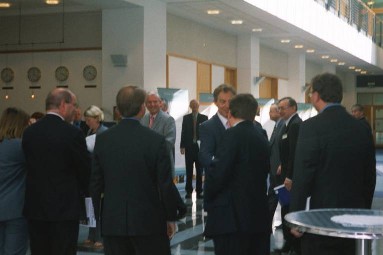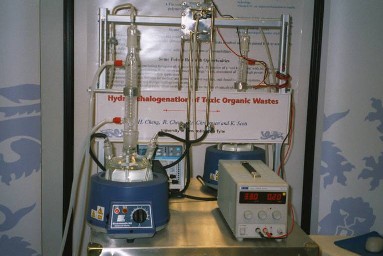Prof. P. A. Christensen
Home
Research and 3rd strand areas
News and recent publications
Vacancies
Information for group members
Clarizon Ltd
Services to business
Updated: 28 Jan 09
|
Water and the environment
The research in these areas within the group is focussed under the following broad headings:
Photoelectrocatalysis using UV/TiO2 ( in collaboration with Dr. T. A. Egerton)
The use of UV-irradiated TiO2 has been investigated for many years as a possible method for the disinfection (bacteria/pathogens) and /or detoxification (organics) of water. The simplest approach is to add the TiO2 photocatalyst as a powder to the contaminated water and irradiate with UV light of l < ca. 400 nm. For a Powerpoint presentation giving the background to TiO2 photocatalysis and our photoelectrocatalytic approach, and some results, click here. A list of papers from the group on this area can be found here.
Electrochemical ozone generation
Ozone is a powerful oxidising agent and a clean alternative to chlorine in water treatment. However, the current method of ozone generation is cold corona discharge, which is relatively inefficient, and it requires cold & very dry air. Professor K. Y. Chan in the University of Hong Kong has developed a patented electrocatalyst for ozone generation and, in collaboration with our group, has shown current efficiencies as high as 80% at room temperature in aqueous electrolyte. Mr. C. Dyson (TagTig Ltd.), Professor K. Y. Chan, Professor Christensen and Dr. Lin have spun out a company from the two Universities to exploit this IP, Clarizon Limited. For further information, click here.
Electrochemical HydroDehalogenation (HDH, in collaboration with Prof. B. T. Golding and Prof. K. Scott)
Halogenated liquid wastes are routinely produced by industrial processes, and the halogenated organic compounds they contain are often toxic to biological systems and resistant to bio-degradation.
Increasingly stringent European and UK legislation has restricted the options for waste treatment essentially to incineration.
Typical market prices for incineration are from £200 per Tonne for simple chlorinated compounds in liquid waste to £2000 per Tonne for PolyChlorinatedBiphenyls (PCBs) and pesticides. These costs are substantially higher than those associated with the treatment of non-halogenated liquid wastes by conventional means, of ca £25 - £55 per Tonne. One million tonnes of ‘standard’ halogenated liquid wastes are produced in the UK per annum.
To learn more about electrochemical HydroDeHalogenation and the technology developed in Newcastle, click here. For papers on HDH, click here and for papers on nitrate reduction using the same technology click here.

Professor Christensen (back to camera [good job!]) meeting the Prime Minister, The Right Honorable Tony Blair, at the launch of the North East Science and Industry Council, Samsung, Peterlee 26 July 2002

Prototype electrochemical HDH reactor exhibited at the launch of the North East Science and Industry Council, Samsung, Peterlee 26 July 2002
Home
|



